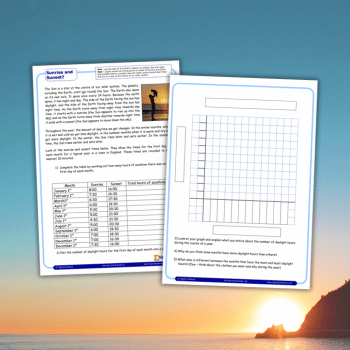This day and night Year 5 science worksheet explains the Earth’s orbit around the sun, and on its own axis. It tasks students with looking at daylight hours on the first of each month for a year.
Don’t worry though – you don’t need to be up at sunrise every day. The download includes a table with average times. Students can then plot this data on the graph provided and note any patterns.
Learning objectives
- Use the idea of the Earth’s rotation to explain day and night
- Learn that the sun is a star at the centre of our solar system
Day and night Year 5 activity
First, students need to complete the given table by working out how many hours of sunshine there was on the first day of each month for a typical year in a town in England.
They then need to plot the number of daylight hours for the first day of each month into a bar graph. What do they notice about the number of daylight hours during the course of a year?
Why do some months have more daylight hours than others? What else is different between the months that have the most and least daylight hours?
Find out more about Sigma Science at sigmascience.co.uk.














